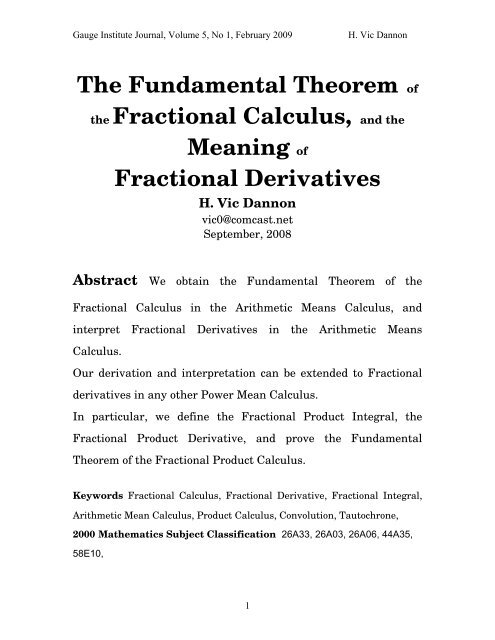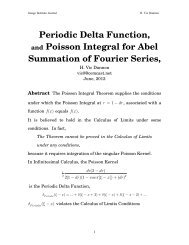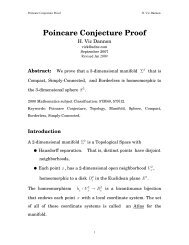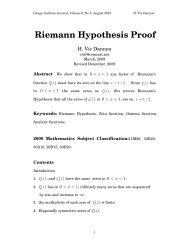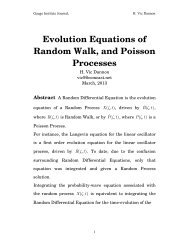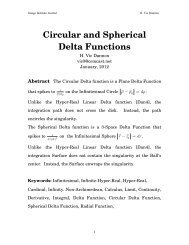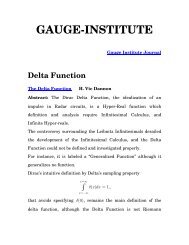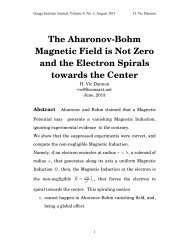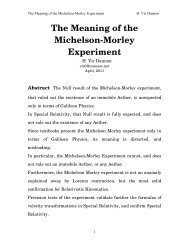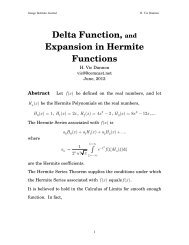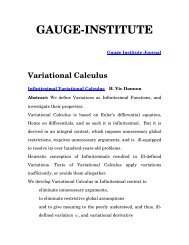Fractional Calculus - Gauge-institute.org
Fractional Calculus - Gauge-institute.org
Fractional Calculus - Gauge-institute.org
Create successful ePaper yourself
Turn your PDF publications into a flip-book with our unique Google optimized e-Paper software.
<strong>Gauge</strong> Institute Journal, Volume 5, No 1, February 2009H. Vic DannonThe Fundamental Theorem ofthe <strong>Fractional</strong> <strong>Calculus</strong>, and theMeaning of<strong>Fractional</strong> DerivativesH. Vic Dannonvic0@comcast.netSeptember, 2008Abstract We obtain the Fundamental Theorem of the<strong>Fractional</strong> <strong>Calculus</strong> in the Arithmetic Means <strong>Calculus</strong>, andinterpret <strong>Fractional</strong> Derivatives in the Arithmetic Means<strong>Calculus</strong>.Our derivation and interpretation can be extended to <strong>Fractional</strong>derivatives in any other Power Mean <strong>Calculus</strong>.In particular, we define the <strong>Fractional</strong> Product Integral, the<strong>Fractional</strong> Product Derivative, and prove the FundamentalTheorem of the <strong>Fractional</strong> Product <strong>Calculus</strong>.Keywords <strong>Fractional</strong> <strong>Calculus</strong>, <strong>Fractional</strong> Derivative, <strong>Fractional</strong> Integral,Arithmetic Mean <strong>Calculus</strong>, Product <strong>Calculus</strong>, Convolution, Tautochrone,2000 Mathematics Subject Classification 26A33, 26A03, 26A06, 44A35,58E10,1
<strong>Gauge</strong> Institute Journal, Volume 5, No 1, February 2009H. Vic DannonContentsIntroduction………………………………………………………………..…………41.<strong>Fractional</strong> Integral and Derivative………………………………………….61.1 Liouville’s <strong>Fractional</strong> Integral of order −1….…………………….………....621.2 Liouville’s <strong>Fractional</strong> Derivative of order 1 ………........................... ..........622. The Fundamental Theorem of the <strong>Fractional</strong> <strong>Calculus</strong>………….....82.1 Operational Derivation of the Fundamental Theorem……………...............82.2 Direct Derivation of the Fundamental Theorem…………………………….103. The Meaning of the <strong>Fractional</strong> Derivative…………..…………………..123.1 Slope of the Convolution Transform…………….……………….…………...123.2 Rate of change of the Convolution Transform………………….……………123.3 Arithmetic mean of the Convolution Transform……….............................133.4 <strong>Fractional</strong> <strong>Calculus</strong>, and Arithmetic Mean <strong>Calculus</strong>…...………………….133.5 The Meaning of Higher Order derivatives of order 1 2 …………………..….133.6 The Applicability of the <strong>Fractional</strong> <strong>Calculus</strong>………………………………...144. The Tautochrone Problem and the Fundamental Theorem………..154.1 The Tautochrone Problem………………………………………………………154.2 The Tautochrone differential Equation……………… ………………………164.3 The Tautochrone Integral Equation…………...……………………………...174.4 The Tautochrone <strong>Fractional</strong> Equation………………………………………..174.5 The Tautochrone and the Fundamental Theorem…………………………..174.6 The Cycloid Differential Equation…………………………………………….194.7 The Cycloid parametric Equation……………………………………………..192
<strong>Gauge</strong> Institute Journal, Volume 5, No 1, February 2009H. Vic Dannonν( a ν)= ( −1) Γ ( a + ν) x− + ,and concluded [Ross] thatdνν( dx)xΓ ( a + ν)xΓ()a−aν− ( a+ν)= ( −1)Many years later, the meaning of <strong>Fractional</strong> Derivatives is stillunclear.The common perception is that the <strong>Fractional</strong> Derivative Methodrepresents a new kind of <strong>Calculus</strong>, such as the Product <strong>Calculus</strong>,that is based on the Geometric Mean [Dan1],But so far, the <strong>Fractional</strong> Derivative Method has been developedonly as a refinement of the Arithmetic Means <strong>Calculus</strong>, and is nota new kind of <strong>Calculus</strong>, such as the Product <strong>Calculus</strong> is.Here, We interpret the <strong>Fractional</strong> Derivative in the context of theArithmetic Means <strong>Calculus</strong> in which it was presented.We notethat it can be similarly developed, and interpreted in the Product<strong>Calculus</strong>.We proceed with the simplest fraction q =1. The <strong>Fractional</strong>integral2and the derivative−12f−1D212d≡ f ,−( dx)12 121df( dx) 2≡ Df.5
<strong>Gauge</strong> Institute Journal, Volume 5, No 1, February 2009H. Vic Dannon12 1≡212df( dx ( − a))as the convolution of the function f () x , with the Kernel functionDfx −32Γ− ( )12, over the interval [ ax , ]u31= x3 x− 2−We use the notations( )2∫ x −u f( u) du ≡ ∗ f( x).Γ− ( ) Γ− ( )1 12 u=a211 df21−32≡ ≡21 1 ∫ −2Df ( x u) fudu ( )Γ− ( )( dx ( − a))2u=xu=a7
<strong>Gauge</strong> Institute Journal, Volume 5, No 1, February 2009H. Vic Dannon2.The Fundamental Theorem of the<strong>Fractional</strong> <strong>Calculus</strong>The meaning of the <strong>Fractional</strong> derivative follows from theFundamental Theorem of the <strong>Fractional</strong> <strong>Calculus</strong>.This theorem is nowhere stated in the standard literature, suchas the books by Miller and Ross [Mil], or Oldham and Spanier[Old], or Podlubny [Pod], and the meaning of the fractionalderivative remains there unknown.To keep it simple, we focus here on the <strong>Fractional</strong> <strong>Calculus</strong> oforder 1 , and later of order 1 .2 3The Fundamental Theorem of the <strong>Fractional</strong> <strong>Calculus</strong> of order 1 2is1−12 2( )( )Dfx ( ) = DF xWe first outline the proof of this theorem by an operationalderivation. Then, we establish it with a direct proof.2.1 Operational Derivation of the Fundamental TheoremProof Outline:8
<strong>Gauge</strong> Institute Journal, Volume 5, No 1, February 2009H. Vic DannonSince the <strong>Fractional</strong> Derivative, and <strong>Fractional</strong> Integral operatorsapply successively [Old] under the ruleα β α+βd d df ( x) =f( x),( dx ( −a) ) ( dx ( −a) ) ( dx ( −a))α β α+βwe have the Fundamental Theorem of the <strong>Fractional</strong> <strong>Calculus</strong>d1 12 2d−( dx ( −a) ) ( dx ( −a))−1 12 2f ( x) = f( x).Applying to both sides the <strong>Fractional</strong> Derivative operatorwe have,d12( dx ( − a))121 1 1 12 2 2 2d d d df ( x) =f( x)−( dx ( −a) ) ( dx ( −a) ) ( dx ( −a) ) ( dx ( −a))−1 1 1 12 2 2 2Composing the first two operators, we conclude thatThat is,−1 12 2d d df ( x) =f( x)( dx ( − a))−( dx ( −a) ) ( dx ( −a))( )1 12 21 12 2( − )DF x = D f ( x).This outline becomes the proof if we supplement it with the proofof the exponent rule [Old]. Instead, we give a direct derivation ofthe Fundamental Theorem.9
<strong>Gauge</strong> Institute Journal, Volume 5, No 1, February 2009H. Vic Dannon2.2 Direct Derivation of the Fundamental TheoremProof:( −1) d dDF2 ( x ) =f ( x )−12( dx ( − a)) ( dx ( − a))d 1−1= ( x −u) 2f( u)du( − ) Γ()∫( dx a)12u=xu=a−121 d−1= ( x −u) 2f( u)duΓ()dx∫12u=xu=aBy Leibnitz Rule for Differentiation of Integrals, [Spieg, p. 95],ddxu= ψ( x) u=ψ( x)∫ Gxudu ( , ) = ∫ ∂xGxudu ( , ) + ϕ'( xGx ) ( , ϕ( x)) −ψ'( xGx ) ( , ψ( x)).u= ϕ( x) u=ϕ( x)If we take−12Gxu (, ) = ( x− u) fu (), then Gxx (, ) is not defined. Toremove the singularity, we integrate by partsu= x u=xu=x−1 1 1⎡⎤( x − u) 2f( u) du = 2( x u) 2f( u) 2 ( x u) 2⎢ − ⎥ − − f '( u)du⎣⎦∫ ∫u=au= a u=aTherefore,u=x1 12 2=−2( x −a) f( a) −2 ( x −u) f '( u)du∫u=a10
<strong>Gauge</strong> Institute Journal, Volume 5, No 1, February 2009H. Vic Dannon⎧u x(1)1 d=⎫−1 1DF2( x) =− ⎪2( x a) 2f ( a) 2 ( x u) 2⎨ − + − f '( u)du ⎪⎬Γ()1 dx∫2⎪⎩u=a⎪⎭⎧1u=x⎫1 d1−=− ⎪( x a) 2f( a) 2( x u) 2⎨ − + − f '( u)du⎪⎬Γ()1dx∫2⎪⎩u=a⎪⎭If we take Gxu (, ) = 2( x− u) 2fu (), then by Leibnitz rule1⎧1u=x⎫1 1−−=− ⎪( x a) 2f( a) ( x u) 2⎨ − + − f '( u)du⎪⎬Γ()1∫ (H )2⎪⎩u=a⎪⎭Integrating by parts with respect to uu= x u=xu=x−1 1 3⎡ − ⎤( )2'( ) ( )2( ) 1−x − u f u du = x u f u ( x u) 2⎢ − ⎥ + − f( u)du⎣⎦∫ ∫2u=au= a u=aSubstituting into (H ),−u=x1 32 1−2=−( x − a) f( a) + ( x −u) f( u)duu=x( − ) 11()1 22 u=aSince Γ− (1+ 1) =−1Γ− (1),∫2u=a1−32 2DF ( x) =− ( x −u) f ( u)duΓ∫ .2 2 2( −1)1−3DF2( x) = ( x −u) 2f ( u)duΓ− ( )∫112u=xu=a= Dfx2().11
<strong>Gauge</strong> Institute Journal, Volume 5, No 1, February 2009H. Vic Dannon3.The Meaning of the <strong>Fractional</strong>DerivativeThe Fundamental Theorem of the <strong>Fractional</strong> <strong>Calculus</strong> of order 1 2is the key to the meaning of the <strong>Fractional</strong> Derivative of order 1 . 2The following are interpretations of the Fundamental Theorem ofthe <strong>Fractional</strong> <strong>Calculus</strong> of order 1 , stated as21−12 2( )Dfx ( ) = DF ( x).3.1 Slope of the Convolution TransformThe <strong>Fractional</strong> Derivative of order 1 of f ( x ) at x is the slope of the2tangent to the curve of the Convolution Transform12( −F) ( x )at x .3.2 Rate of Change of the Convolution TransformThe <strong>Fractional</strong> Derivative of order 1 2of f () x at x is the rate ofChange of12( −F) ( x ) at x .12
<strong>Gauge</strong> Institute Journal, Volume 5, No 1, February 2009H. Vic DannonIn [Dan1], we presented the Arithmetic Mean <strong>Calculus</strong>, andinterpreted the Fermat-Newton-Leibnitz Derivative in it.In terms of the Arithmetic Mean <strong>Calculus</strong>, we have3.3 Arithmetic Mean of the Convolution TransformThe <strong>Fractional</strong> Derivative of order 1 2of f () x at x is the ArithmeticMean of the Convolution Transform12( −F) ( x )over [ xx , + dx].More generally,3.4 <strong>Fractional</strong> <strong>Calculus</strong>, and Arithmetic Mean <strong>Calculus</strong>The <strong>Fractional</strong> <strong>Calculus</strong> of order 1 of f ( x ) is the Arithmetic Mean2<strong>Calculus</strong> of the Convolution Transform12( −F) ( x ) .3.5 The Meaning of Higher Derivatives of order 1 2The Fundamental Theorem of the <strong>Fractional</strong> <strong>Calculus</strong> of order 1 2enables us to interpret <strong>Fractional</strong> Derivatives of order n +1as2higher derivatives of the Convolution Transform12( −F) ( x ) . Inparticular,3 1 12 2 2 −2( )D f( x) = DD f( x) = D F ( x)5 1 12 2 2 3 −2( )D f( x) = D D f( x) = D F ( x)13
<strong>Gauge</strong> Institute Journal, Volume 5, No 1, February 2009H. Vic DannonThe meaning of order n +1<strong>Fractional</strong> Derivative follows from21 1 12 2 + 1 2n + n n ( − )D f( x) = D D f( x) = D F ( x).3.6 The Applicability of the <strong>Fractional</strong> <strong>Calculus</strong>The meaning of the <strong>Fractional</strong> Derivative enables us to evaluatethe applicability of the <strong>Fractional</strong> <strong>Calculus</strong> in simple terms:The <strong>Fractional</strong> Derivative of order 1 2may be useful in a modelthat involves the Convolution Transform12( − )F ( x). That is,If you can see the Convolution Transform underlying your model,you may be well served by the <strong>Fractional</strong> Derivative.The solution of the Tautochrone Problem in the next section withthe aid of the Fundamental Theorem, shows thatthe required Convolution Transform modeling and identification isfar from self-evident.14
<strong>Gauge</strong> Institute Journal, Volume 5, No 1, February 2009H. Vic Dannon4.The Tautochrone Problem and theFundamental TheoremThe Tautochrone Problem is associated with Abel [Abel]. Itssolution by Abel involves the use of the Fundamental Theorem.4.1 The Tautochrone ProblemA bead of mass m slips along a frictionless wire,from heightto heightη = y , at time t = 0η = 0, at time t = T .We want to find the smooth curve -if there is such curve- alongwhich the bead’s falling time is the same for any y . To that end,15
<strong>Gauge</strong> Institute Journal, Volume 5, No 1, February 2009H. Vic Dannonwe look for a differential equation that will describe such motion.4.2 The Tautochrone Differential Equationds( y − η )=−2gdtProof:The potential energymg( y − η)converts into the kinetic energy122⎛ds⎞m ⎜⎜⎝ dt ⎠ ⎟,wheres= s( η)is the arc-length of the curve. Therefore,ds=± 2( gy− η).dtSince the particle speed is in the direction of− y , we havedsdt=− 2( gy−η)s'( η)dη( y − η )=−2gdt.Integrating the right side over the time interval, and the left overthe height interval we obtain an integral equation for the curve ofthe bead’s motion:16
<strong>Gauge</strong> Institute Journal, Volume 5, No 1, February 2009H. Vic Dannony( α) = (1− cos2 α),a2Proof:By 5.6,Substitutingwe have,xη=ya= ∫ −1dη.ηη=0η = a sin 2 θ,2y asinα= ,aη− 1 cos1 = θ12sin θ− = sin θ,dη = 2asinθcosθdθ,θ=α2x = 2a ∫ cos θdθθ=0θ=α∫= a (1 + cos 2 θ)dθ2θ=0=a(2α + sin 2 α).2y = asinα= (1 − cos 2 α).a2The Tautochrone problem is treated by Nahin [Nahin] bytraditional methods.20
<strong>Gauge</strong> Institute Journal, Volume 5, No 1, February 2009H. Vic Dannon1 1 23 3 + 1 3n + n n ( − )D fx () = DDfx () = D F () xSimilarly,5 2 13 3 2 −3( )Dfx ( ) = DDfx ( ) = DF ( x),and2 2 13 3 + 1 3n + n n ( − )D f( x) = D D f( x) = D F ( x).23
<strong>Gauge</strong> Institute Journal, Volume 5, No 1, February 2009H. Vic Dannon6.The <strong>Fractional</strong> Product <strong>Calculus</strong>We developed the Product <strong>Calculus</strong>, or Geometric Mean <strong>Calculus</strong>in [Dan1]. The Product Derivative and the Product Integral ofthat <strong>Calculus</strong> are related by the Fundamental Theorem of theProduct <strong>Calculus</strong> [Dan1]The <strong>Fractional</strong> Derivative, and the <strong>Fractional</strong> Integral can bedefined in the context of the Product <strong>Calculus</strong> to yield a <strong>Fractional</strong>Product <strong>Calculus</strong>.We outline here the development of the <strong>Fractional</strong> Product<strong>Calculus</strong> of order 1 , with its Fundamental Theorem. We keep the2notations of [Dan1]6.1 Definition of <strong>Fractional</strong> Product Integral of Order 1 211 122 D−f x −2(0) −ln ( )( )( D ) f( x) ≡e ≡ G ( x)6.2 Definition of <strong>Fractional</strong> Product Derivative of Order 1 21212(0) ln ( )D f x( D ) f( x) ≡ e24
<strong>Gauge</strong> Institute Journal, Volume 5, No 1, February 2009H. Vic Dannon6.3 The Fundamental Theorem of the <strong>Fractional</strong> Product<strong>Calculus</strong> of Order 1 2Proof:−{ }1 12 2(0) (0) (0)( D ) f( x) = D ( D ) f( x)⎧−1⎫(0)Dlog ⎪( D ) 2 f( x)⎪1⎨⎬(0) (0) − 2⎪⎩⎪⎭D ( D ) f( x)= e= e= e= eD⎧⎪⎨⎪⎩12 log ( )log D −⎪ef x−1DD 2 log f ( x )1D 2 log f ( x )(0)12= ( D ) f( x)⎫⎪⎬⎪⎭This leads to the interpretation of the <strong>Fractional</strong> Productderivative of order 1 2 .6.4 The Geometric Mean of the Convolution TransformThe <strong>Fractional</strong> Product Derivative of order 1 of f ( x ) at x is the2Geometric Mean of12( −G) ( x )over [ xx , + dx].25
<strong>Gauge</strong> Institute Journal, Volume 5, No 1, February 2009H. Vic DannonReferences[Abel] Abel, Niels, “Solution de quelques problemes a l’aide d’integralesdefinies”, Oeuvres Completes, Christiania (Grondahl) 1 1881, pp. 16-18.[Dan1] Dannon, Vic, “Power Mean <strong>Calculus</strong>, Product <strong>Calculus</strong>, HarmonicMean <strong>Calculus</strong>, and Quadratic Mean <strong>Calculus</strong>”, <strong>Gauge</strong> Institute Journal ofMath and Physics, Vol. 4, No. 4, November 2008.[Lac] Lacroix, S., Traite du Calcul Differentiel et du Calcul Integral, 2 ndedition, 1819, pp. 409-410.[Liou] Liouville, Joseph, “Memoire sur le Theoreme des complementaires”, J.Reine Angew. Math., 11, 1834, pp. 1-19[Mil] Miller, Kenneth, & Bertram Ross, “An Introduction to the <strong>Fractional</strong><strong>Calculus</strong> and <strong>Fractional</strong> Differential Equations”. Wiley, 1993.[Nahin] Nahin, Paul, “When Least is Best”, Princeton University Press, 2004.[Old] Oldham, Keith, & Spanier, Jerome, “The <strong>Fractional</strong> <strong>Calculus</strong>”,Academic Press, 1974.[Ross] Ross, Bertram, “<strong>Fractional</strong> <strong>Calculus</strong>”, Mathematics Magazine Vol. 50No.3, May 1977.[Pod] Podlubny, I., “<strong>Fractional</strong> Differential Equations” Academic Press, 1999.26


